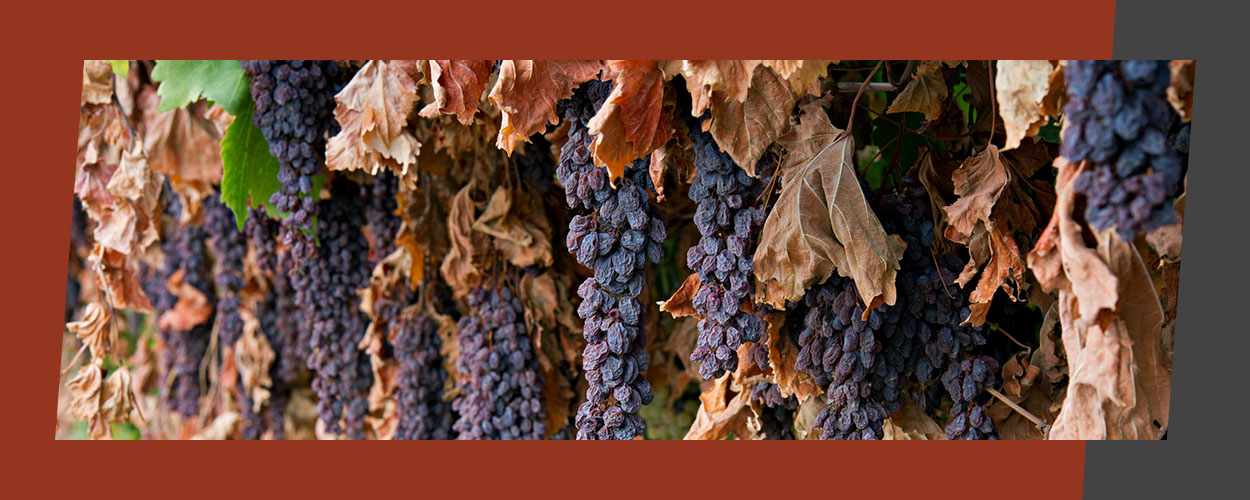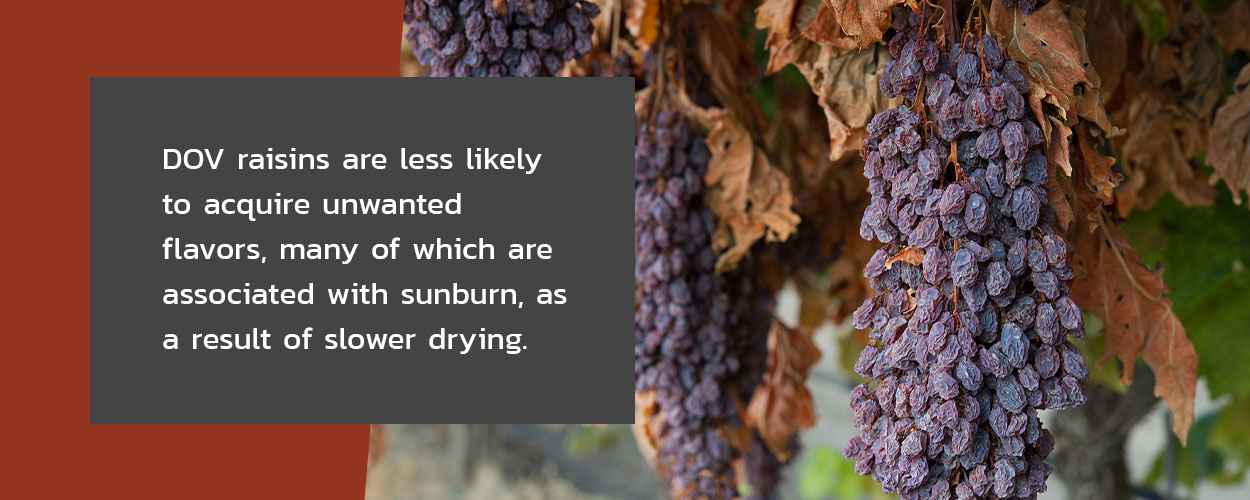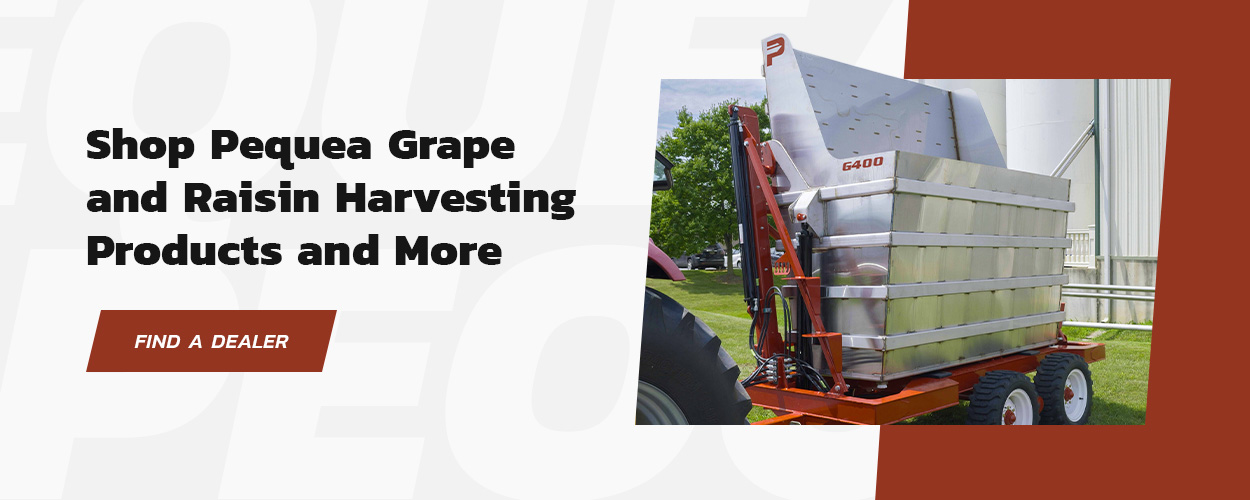Dry-on-Vine Raisin Harvesting Process
Farmers and raisin growers are highly adaptive individuals, and many are changing their drying processes to produce optimal yields with fewer human resources.
The landscape for California raisins has evolved over the past few years, and dried-on-vine raisins are causing quite a positive shakeup. California has long been one of the biggest raisin producers globally. However, due to competition from Turkey, China and Iran, the United States now sits as the fourth largest raisin producer in the world.
Many California raisin farmers have shifted to the dry-on-vine method to keep up with international competitors, minimize labor costs and streamline harvesting. Learn about the dry-on-vine raisin harvesting process and see why dried-on-vine raisins are the future for California raisins.
Raisin Drying Processes
Although there are various raisin drying methods, two predominant processes today are dry-on-vine (DOV) and tray-drying. There are many differences between the two drying processes, and the raisin characteristics also differ.
Tray-Dried Raisins
The traditional method of creating California raisins is to place Thompson Seedless grapes cut in clusters on paper trays, allowing them to dry in direct sunlight on the ground in a vineyard. This particular drying process results in the familiar caramelized taste and texture of raisins that have existed for some time.
Dried-on-Vine Raisins
For this method, farmers typically use Selma Pete grapes. However, depending on the conditions and market segment, a raisin farmer might use anything from Thompson Seedless to Diamond Muscat for their dried-on-vine raisins.
For DOV raisins, farmers may need to first cut the canes to restrict moisture intake. Then, the grapes are left to dry on the vine under the sun, though they receive some shade. This more natural grape drying process produces juicier and sweeter raisins.
Dried-on-Vine vs. Tray-Dried Raisins
Due to the higher temperatures tray-dried raisins are exposed to — between 30-40 degrees Fahrenheit above ambient or shade temperatures — they have more wrinkles and are less round, with a distinctly more robust flavor. Additionally, tray-dried raisins tend to take substantially less time to dry due to direct sunlight exposure — DOV raisins can take 30-40 days to dry, while tray-dried raisins are ready in as little as 10-20 days.
DOV raisins require less extensive monitoring and are at lower risk of weather and temperature changes. Ultimately, the DOV raisin drying process means a longer drying process with increased drying process control.
Benefits of Dry-on-Vine Raisins
Dry-on-vine raisins are produced under the canopy's shade while still attached to the vine. The longer drying process is a trade-off for less manual labor and a higher-quality end product. DOV raisins are less likely to acquire unwanted flavors, many of which are associated with sunburn, as a result of slower drying.
Regarding which grapes work best for DOV, Sultana, Muscat and Fiesta Seedless varieties are good options. However, Selma Pete grapes offer early ripening, which may counter the longer drying process. Several benefits stem from using the DOV drying process, as it:
- Produces juicier and plumper raisins.
- Ensures milder raisin taste and superior flavor retention.
- Offers a lower risk of sunburn and over-drying.
- Means fewer manual labor costs.
- Results in saving on costs of paper trays.
- Provides an efficient means of harvesting as raisins are machine-harvested.
- Eliminates the need to cut grapes from the vine and place them on trays.
- Cuts out the need to prepare a terrace between vine rows.
Raisin farmers looking to optimize their vineyards and drying methods should strongly consider the benefits of the dry-on-vine raisin harvesting process.
The Dry-on-Vine Raisin Harvesting Process
Thompson Seedless or Sultana grapes have been a main contributor to the U.S. raisin supply for many years. Fiesta and Selma Pete stand out as two more viable raisin grape varieties worth considering.
California grows and harvests an increasing number of DOV raisins, which are uniquely processed and differ immensely in drying process, flavor, consistency and harvesting method. Farmers must have enough lucrative crops to make dried-on-vine California raisins viable, as the initial equipment investment is high. Still, it offers a competitive means to maximize output.
DOV Drying Process
Instead of continuing with the labor-intensive process of cutting clusters of grapes and transferring them to drying trays, raisin farmers can cut the canes and leave the grapes to dry on the trellises. Furthermore, certain raisin grape species dry on vine without the costly step of cane cutting.
The Use of Harvesters
The DOV harvesting process requires a high level of skill and precision to ensure the timing is correct and the highest yield is harvested in the shortest timeframe. Just as there are several benefits of machine harvesting for grapes compared to hand picking, there are also upsides to using harvesters for DOV raisin harvesting.
Self-propelled or tow-behind harvesters straddle each grapevine row and steadily move along, breaking the raisins loose using a combination of a trunk and canopy shaker and hook-shaped bow rod heads. The added shaking also helps mitigate vine damage as the harvester separates the raisins from the vine.
After the raisins fall, they land on the catching system, designed in an overlapping structure of flexible material such as nylon. The unidirectional plates allow trunks and trellis posts to pass while ensuring the raisins are rapidly deposited into a bucket conveyor belt system.
As the harvester passes over the row, the conveyor belt travels across the top of the harvester and enters the over-the-row (OTR) conveyor system. Due to the slow speed of the harvester and the control of the bucket conveying system, there is minimal spillage before the raisins are carried from the shoot and deposited in bins.
Harvester Cleaning and Separating Systems
Harvesters have other fundamental features, including an essential cleaning fan system that is part of the cleaning and separating system. Throughout the cleaning process, canes, leaves, green shoots and other non-raisin materials are separated from the OTR conveyer system that deposits the raisins in the food-safe companion gondola or bin trailer. Most OTR conveyor belts are equipped with magnets to pick up any metallic objects that could damage processing machinery.
Processing
Once the gondola is filled, the harvester slows, and the tractor carrying the harvested raisins takes them for processing — all accomplished in a fraction of the time it would take to dry and harvest tray-dried raisins.
Shop Pequea Grape and Raisin Harvesting Products and More
At Pequea, we manufacture American-made products that offer superior quality, built with farmers like you in mind. That's why, apart from our superior range of agricultural equipment, we provide machinery parts and services for all your Pequea products.
We offer several harvesting products, including our Pequea G300 Grape Gondola, expertly designed and fashioned from 304 stainless steel. This easy-to-use equipment has hydraulics and a 3-ton capacity to promote efficiency and reduce spillage. What's more, our orchard and vineyard spreaders are designed with the confines of vineyards in mind to offer a versatile and easily maneuverable spreading solution.
Find and contact a dealer near you today to learn more about our vineyard, orchard and harvesting products. Or, call us at (717) 354-4343 with any questions you might have — we are happy to help!


